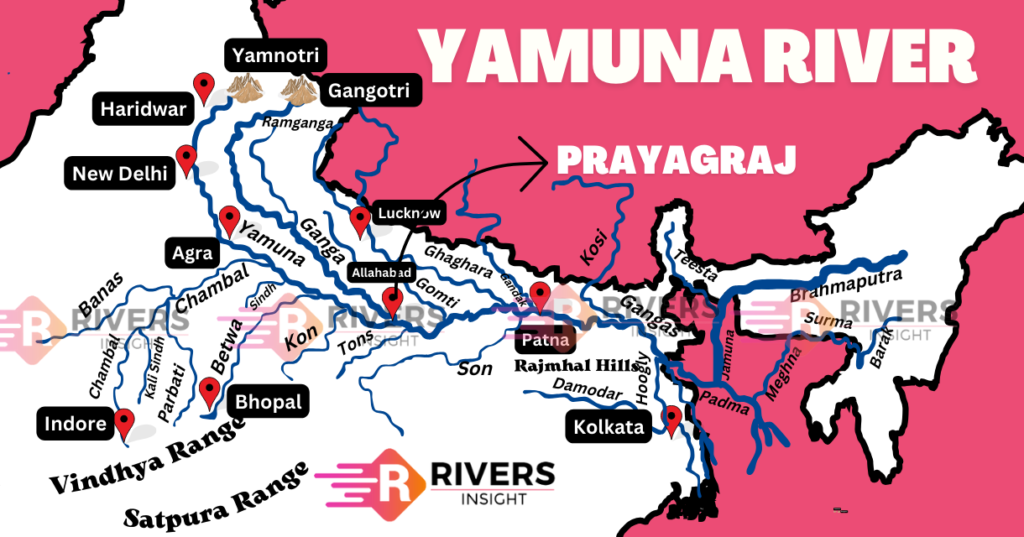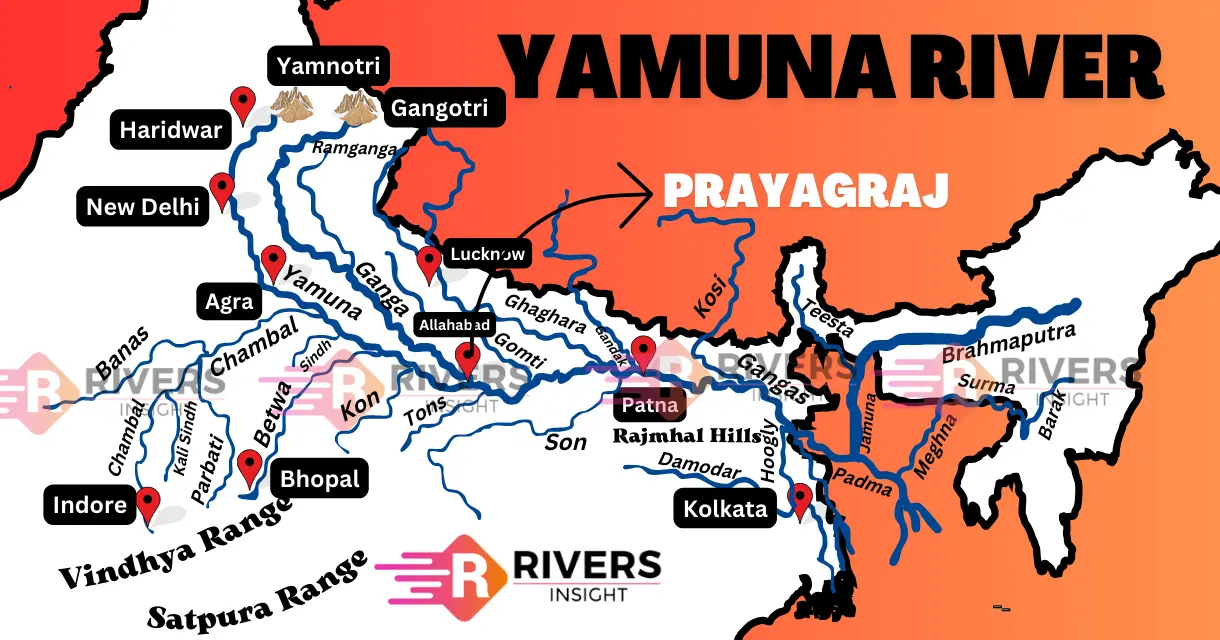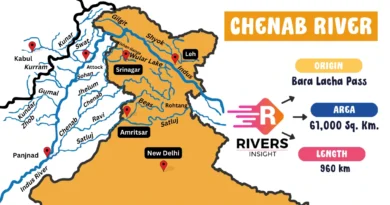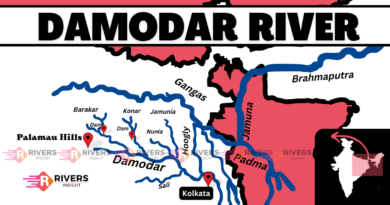Yamuna River System: Detailed Map with Tributaries
The Yamuna River is a major river in India and is a tributary of the Ganga River. It starts from the Yamunotri Glacier in the Himalayas and flows about 1,376 kilometers through the northern plains of India before joining the Ganges River at Allahabad.
In this article, we’ll explore everything about the Yamuna River System—its Geographical Features, including where it flows and what it looks like on a map with route, its historical importance, dams, tributaries, and major cities along its banks.
| River | Yamuna River |
| Origin | Yamunotri Glacier |
| Length | 1376 km |
| Join Ganga at | Allahabad |
Table of Contents
Geographical Features of the Yamuna River System
- Originates from the Yamunotri Glacier in Uttarakhand, India.
- Flows through multiple states: Uttarakhand, Himachal Pradesh, Haryana, Delhi, and Uttar Pradesh.
- Spans approximately 1,376 kilometers (855 miles) in length.
- Creates a broad floodplain upon entering the North Indian Plains, characterized by fertile alluvial soil.
- Exhibits varying widths along its course, featuring narrow stretches and wider sections.
- Tributaries include the Tons River, the Hindon River, and the Chambal River.
- Plays a crucial role in supporting agriculture, industry, tourism, and transportation in the regions it flows through.
- Influences the cultural and historical heritage of cities along its banks, such as Delhi, Agra, and Mathura.
Origin & Course of Yamuna River
The Yamuna River begins its journey at the Yamunotri Glacier, nestled in the lower Himalayas at around 6,387 meters above sea level. This glacier, located in Uttarakhand, is where the Yamuna originates.
As it flows downstream, the river passes through several states, including Uttarakhand, Himachal Pradesh, Haryana, Delhi, and Uttar Pradesh. It travels approximately 1,376 kilometers (855 miles) before reaching its confluence with the Ganges River in Prayagraj (formerly Allahabad). This merging point is highly revered in Indian culture as it signifies the meeting of two sacred rivers.
The Yamuna River flows near many important cities and landmarks, each adding to its cultural importance:
- Yamunotri
- Delhi
- Agra
- Mathura
- Haridwar
- Vrindavan
- Allahabad (Prayagraj)
- Etawah
- Noida
- Faridabad
- Hathras
Map of Yamuna River from Start to End

Tributaries of Yamuna
The following are the major Tributaries of the Yamuna River:
- Chambal River
- Sindh River
- Betwa River
- Hindon River
- Ken River
- Tons River
| Tributary | Origin | States Covered | Length |
|---|---|---|---|
| Chambal River | Near Mhow, Madhya Pradesh | Madhya Pradesh, Rajasthan | Approx. 1024 km |
| Sindh River | Malwa Plateau, Madhya Pradesh | Madhya Pradesh, UP, Rajasthan | Approx. 470 km |
| Betwa River | Near Bhopal, Madhya Pradesh | Madhya Pradesh, Uttar Pradesh | Approx. 590 km |
| Hindon River | Saharanpur district, Uttarakhand | Uttarakhand, UP, Haryana | Approx. 400 km |
| Ken River | Near Village Ahirgawan, MP | Madhya Pradesh, Uttar Pradesh | Approx. 427 km |
| Tons River | Tons Glacier, Uttarakhand | Uttarakhand, Himachal Pradesh | Approx. 322 km |
Chambal River
Originating from the Vindhya Range near Mhow in Madhya Pradesh, the Chambal River meanders through Madhya Pradesh and Rajasthan, covering a distance of approximately 1024 kilometers. It boasts a rich biodiversity and is home to the National Chambal Sanctuary, a haven for endangered species. The Chambal Valley’s extensive ravines create a distinct landscape, making it a captivating destination for nature enthusiasts.
Sindh River
Rising from the Malwa Plateau in Madhya Pradesh, the Sindh River traverses Madhya Pradesh, Uttar Pradesh, and Rajasthan over a length of approximately 470 kilometers. It supports agriculture through irrigation and hosts tributaries like the Parwan River and Kali Sindh River. The Sindh River basin sustains diverse flora and fauna, contributing to the region’s ecological balance.
Betwa River
Emerging from the Vindhya Range near Bhopal, the Betwa River flows through Madhya Pradesh and Uttar Pradesh, spanning around 590 kilometers. Its picturesque landscapes, including hills, forests, and ravines, attract nature lovers. The Rajghat Dam harnesses its waters for irrigation and hydropower generation, while the Betwa Wildlife Sanctuary safeguards its rich biodiversity.
Hindon River
Originating from the Saharanpur district in Uttarakhand, the Hindon River meanders through Uttarakhand, Uttar Pradesh, and Haryana before merging with the Yamuna River near Ghaziabad. With a length of approximately 400 kilometers, it sustains avian species and serves as a vital resource for local communities. Conservation efforts aim to restore its ecological health and promote sustainable practices.
Ken River
Beginning its journey near Village Ahirgawan in Madhya Pradesh, the Ken River flows through Madhya Pradesh and Uttar Pradesh, spanning approximately 427 kilometers. Renowned for its scenic beauty, the Ken River passes through the spectacular Ken River Gorge, offering mesmerizing vistas near the Panna National Park. Its tributaries, including the Sonar River and Simiri River, contribute to its pristine surroundings.
Tons River
Originating from the Tons Glacier in Uttarakhand, the Tons River meanders through Uttarakhand and Himachal Pradesh, stretching over approximately 322 kilometers. Its rugged landscapes, adorned with deep gorges, dense forests, and remote valleys, showcase nature’s grandeur. Tributaries like the Yamuna River and Supin River augment its flow, ensuring its significance in the region’s ecosystem.
Dams on the Yamuna River
- Okhla Barrage
- Lakhwar Dam
- Hathnikund Barrage
- Tehri Dam
- Wazirabad Barrage
- Kishau Dam (proposed)
- Tajewala Barrage
- Vishnuprayag Barrage
- Gokul Barrage
- Renuka Dam (proposed)
Pollution in the Yamuna River
- The Yamuna River faces severe pollution due to various sources, including industrial discharge, untreated sewage, agricultural runoff, and solid waste dumping.
- High levels of biological oxygen demand (BOD), chemical oxygen demand (COD), heavy metals, and pathogens pose significant threats to aquatic life and human health.
- The pollution in the Yamuna River not only affects the river ecosystem but also impacts groundwater quality and soil fertility in surrounding areas.
Government Efforts to Address Pollution
- Pollution Control Measures: The government has implemented various pollution control measures, including setting up sewage treatment plants (STPs) to treat domestic and industrial wastewater before discharge into the river.
- River Cleaning Programs: Initiatives like the Yamuna Action Plan (YAP) aim to reduce pollution levels in the river through comprehensive clean-up efforts, including dredging, solid waste management, and afforestation along riverbanks.
- Industrial Regulations: Stringent regulations and enforcement actions are in place to monitor industrial effluents and ensure compliance with pollution control norms. Polluting industries are required to install effluent treatment plants (ETPs) and adhere to effluent discharge standards.
- Sewerage Infrastructure Development: Investments are being made to improve sewerage infrastructure, expand sewage network coverage, and promote the use of eco-friendly sanitation technologies to minimize sewage discharge into the river.
- Public Awareness and Participation: Government agencies engage in public awareness campaigns to educate communities about the importance of clean waterways and the role of individuals in preventing pollution. Citizen participation in river cleaning drives and waste management initiatives is encouraged.
Despite these efforts, challenges persist in effectively combating pollution in the Yamuna River. Continuous monitoring, stringent enforcement of regulations, technological innovations, and collaborative efforts involving stakeholders are essential to achieve sustainable solutions and restore the health of the Yamuna River ecosystem.




